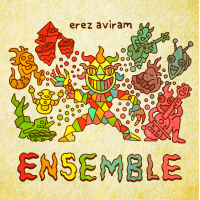Home » Jazz Musicians » Asuka Kakitani Jazz Orchestra
Asuka Kakitani Jazz Orchestra
At the forefront of Brooklyn’s burgeoning big band scene, the Japanese-born composer Asuka Kakitani has attracted some of New York’s finest jazz artists with her adventurous, melodically charged charts. After several years of regular performances around New York City, the dynamically supple 18-piece Asuka Kakitani Jazz Orchestra makes a stunning debut with Bloom, due out January 26 on Nineteen-Eight Records.
Outside of Lincoln Center, virtually all jazz orchestras exist as a labor of love. Kakitani has fostered the necessary dedication among her peers with writing so bright, vivid and personal that it inspires some of New York’s leading improvisers to wondrously expressive heights. Prominently featured among the album’s stellar cast are saxophonist John O’Gallagher, trombonist Jacob Garchik, guitarist Pete McCann, pianist Mike Eckroth, drummer Mark Ferber, and Portuguese-born vocalist Sara Serpa,
“I want to give these fantastic musicians space to express themselves,” says Kakitani, 36. “I write the music and they play it, and I choose players that I feel tell a story. On this recording I got really emotional over how much they understand my music, while at the same time expressing themselves with such passion.”
A series of watercolor washed canvases, Bloom focuses on Kakitani’s original compositions and arrangements, music that unfolds with poetic flair and canny narrative drive. The album opens with the gloriously Technicolor title track, which Kakitani wrote as a BMI Manny Albam commission. While the tune isn’t strictly programmatic, Kakitani clearly draws from nature in the way the sinuously rising introduction evokes the time-lapse emergence of a sun- kissed bloom. The piece climaxes with a Ferber solo that’s a model of melodic drum work, elegant, sassy and precise.
While she often draws inspiration from the natural world, Kakitani also finds soaring sounds in literature and the canvases of modernist masters. “Dance One,” which earned the 2006 BMI Foundation Charlie Parker Award, flowed out of the experience of gazing at Henri Matisse's “Dance 1,” the iconic painting of five naked, hands-linked dancers caught in mid-stride, almost levitating on luminous fields of blue and green. In Kakitani’s adroit hands the dance is life itself, with O’Gallagher’s celebratory and fleet-footed alto eventually giving way to intimations of crepuscular decay with Garchik’s dark, brooding trombone. “I was so inspired by Matisse’s lines and energy,” Kakitani says. “The colors are very strong.”
Kakitani is at her most lyrical on “Opened, Opened” and “Dragonfly's Glasses,” two pieces from her suite “Re-imaging My Childhood,” which premiered in 2009. Funded in part by the Composer Assistance Program of the American Music Center, the pieces are striking reinterpretations of traditional Japanese children’s songs. While the melodies are beautifully unadorned, she finds rich harmonies and gracefully moving lines amidst the playful tunes, creating a beguiling sound unlike any other jazz orchestra on the scene.
Read moreTags
Asuka Kakitani Jazz Orchestra: Bloom

by Dan Bilawsky
The difference between a “big band" and an “orchestra" in jazz is usually more than nominal in nature. On the surface, they may seem the same, but their intent, musical scope and arranging/compositional methodology are usually very different. While it can be seen as a bit of a generalization, the “band" tag often refers to groups that take the straightforward path, while the “orchestras" tend to take the road(s) less traveled. Duke Ellington paved the way for every adventurous jazz ...
Continue Reading-Dan Morgenstern (jazz historian, author, former editor of DownBeat, Director of the Institute of Jazz at Rutgers University)
Music
Recordings: As Leader | As Sideperson
















